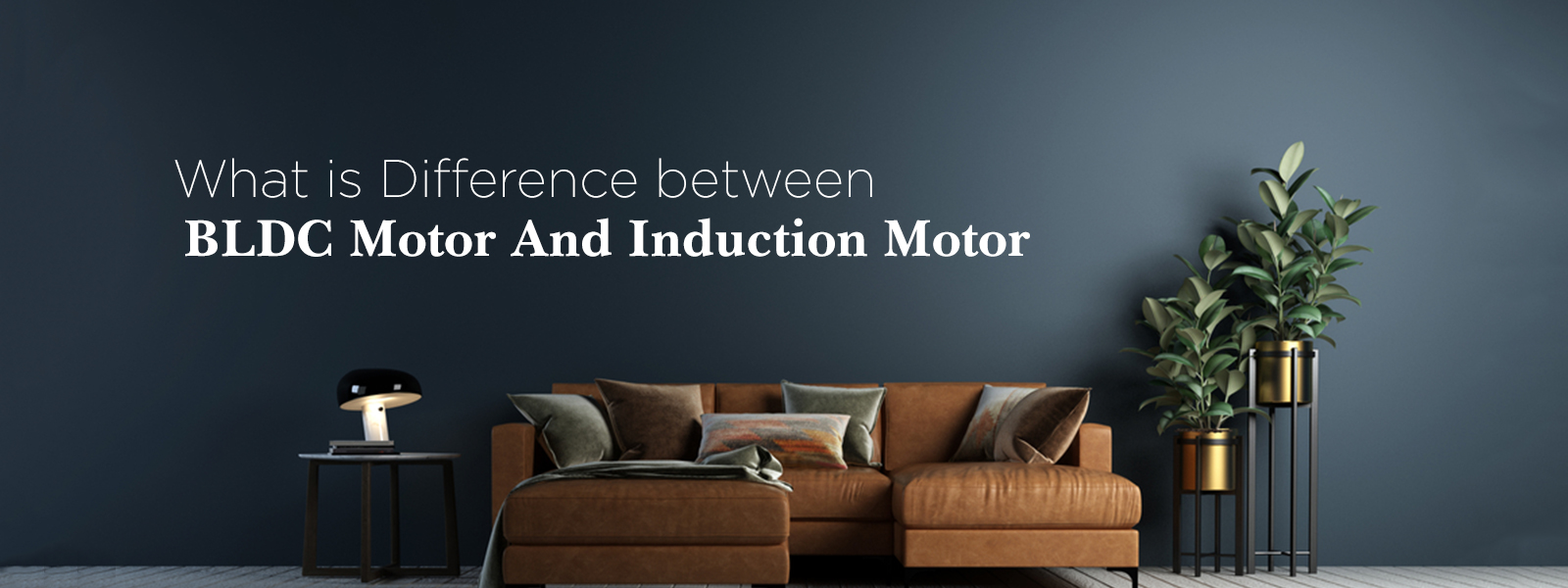
Motors power millions of electric gadgets ranging from fans, air conditioners, washing machines, and industrial machines. With numerous types of motors out there, BLDC motors and induction motors are the most popular to be used for both household as well as business applications. But which one is better? What is the difference? This comprehensive blog explains the BLDC motor vs induction motor in detail so you can see how they work, where they are implemented, and which is suitable for you, primarily if you’re planning to use BLDC Motor Fans at home or in the office.
What is a BLDC Motor?
A Brushless DC motor or BLDC motor is an electric direct current (DC) powered motor that has no brushes for commutation. It uses permanent magnets and electronic controllers to spin instead. The magnets are placed in the rotor, and the stator is made up of windings. A sensorless or sensored controller will help decide when the stator coils should be energised, and the rotor starts to spin. These motors are noted for being compact, having high efficiency, low noise, and acceptable torque and speed control.
What is an Induction Motor?
An asynchronous motor, or an induction motor, operates on alternating current (AC). It doesn’t utilize electronic controllers or magnets, as is the case with BLDC motors. Instead, it works on electromagnetic induction to generate movement. The current in the stator forms the rotating magnetic field, which turns the rotor by inducing current. Induction motors are widely used because they are rugged, inexpensive, and can be directly powered from an AC power source without the need for complicated controllers.
Key Features: BLDC Motor vs. Induction Motor
We will now go into comparison between bldc and induction motor types, describing features important for both industrial and home use.
1. Efficiency
- BLDC Motor: Very efficient because of its brushless nature and permanent magnet. Power suffers little loss to heat or friction.
- Induction Motor: Not as efficient, particularly with part loads. It loses power to heat via stator windings and rotor windings.
BLDC for Better power saving, thus making it acceptable for ceiling fans and battery-operated appliances.
2. Speed Control
- BLDC Motor: Offers wonderful speed control with electronic controllers and is good for variable-speed drives.
- Induction Motor: More challenging and imprecise without the aid of external equipment like VFDs (Variable Frequency Drives). BLDC, suitable for applications like smart fans and electric vehicles.
3. Size and Weight
- BLDC Motor: Small in size and light in weight, as it boasts a high power density and uses advanced materials.
- Induction Motor: Typically, heavier and larger, especially for the same power rating.
BLDC, Easier to design small appliances and miniaturise wall units.
4. Cost
- BLDC Motor: Costlier to buy upfront with electronics and magnets, but less costly to operate.
- Induction Motor: Less costly to manufacture and buy, thus more common in low-cost appliances.
Based on application, Induction motors take cost-sensitive applications; BLDC motors take overall long-term efficiencies.
5. Maintenance
- BLDC Motor: Practically maintenance-free since no brushes need to be replaced.
- Induction Motor: Requires periodic maintenance for bearings and cooling systems, yet otherwise relatively reliable.
BLDC is more adapted to long-term dependability and fewer interventions.
6. Noise Level
- BLDC Motor: Quieter operation due to fewer moving components and commutation smoothness.
- Induction Motor: Noisier operation, especially at high speed.
BLDC, adapted to noise-sensitive applications like bedrooms and libraries.
7. Startup Torque
- BLDC Motor: Provides high startup torque, which is used in applications like electric scooters, compressors, and fans.
- Induction Motor: Lower starting torque unless designed specifically with capacitors or any other characteristic.
BLDC provides higher torque.
Advantages of BLDC Motor over Induction Motor
- Higher Energy Efficiency: Up to 30–50% more efficient than traditional induction motors due to reduced friction and heat generation.
- Excellent Speed Control: Precise speed variation using electronic controllers, making it ideal for smart appliances and variable-speed devices.
- Compact Size and Lightweight: High power density allows smaller and lighter motors.
- Low Noise Operation: Quiet due to lack of brushes and smooth electronic commutation, and is suited for bedrooms, libraries, hospitals, etc.
- Longer Lifespan: Typically lasts 10–15 years or more with minimal maintenance, given less wear and tear.
- Low Maintenance: Practically maintenance-free as there are no brushes to replace, resulting in less downtime and fewer service interventions
- High Starting Torque: Provides instant torque, useful for applications like compressors, e-bikes, and BLDC fans
- Intelligent Control: Supports smart home integration (e.g., remote control, sensors). Also has advanced features like automatic speed adjustment, motion detection, etc.
- Better Thermal Management: Lower heat generation allows for better thermal performance and longevity.
The bldc motor vs induction motor question is all about what matters most to you: performance and efficiency or cost and ease. BLDC motors are the future when it comes to energy-saving devices and intelligent systems. With their quiet operation, precise control, and long lifespan, they are gaining huge popularity, particularly for home appliances such as BLDC Motor Fans.
Frequently Asked Questions
BLDC motors are even cheaper to repair since they do not consist of brushes, which deteriorate first in other motors.
BLDC motor fans are more suitable for home use since they use energy effectively, run quietly, and have intelligent speed control functionalities. They even save on electricity bills in the long term.
Although BLDC motors are great for precision and efficiency, induction motors are inexpensive for industrial-grade or heavy-duty uses where tighter speed control is not important.
BLDC motors typically last longer since they have fewer wear-and-tear components. They can last up to 10–15 years or more with little maintenance.
BLDC motors usually use DC power, and need a controller, whereas induction motors use AC power directly from the grid. This is one of the most significant differences in comparison between bldc and an induction motor.


